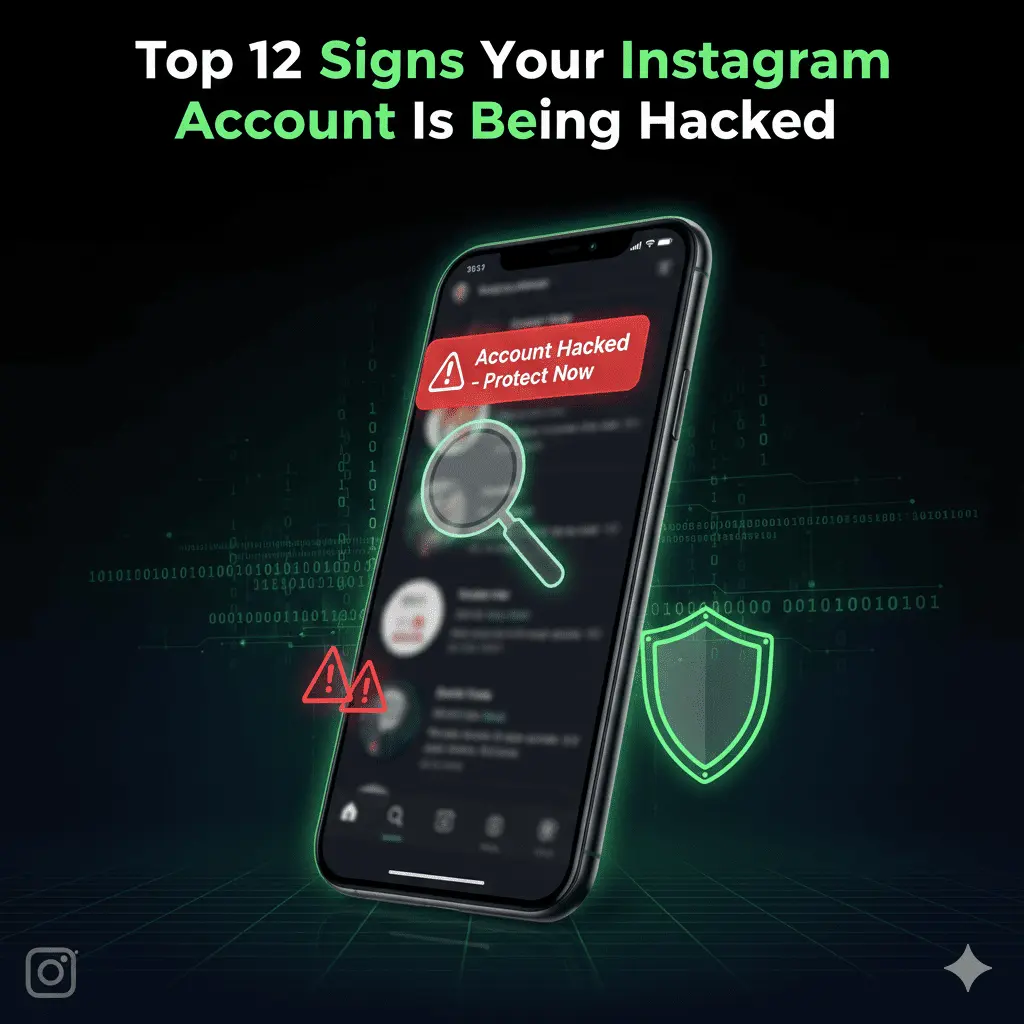Subtotal $0.00
Top 12 Signs Your Instagram Account Is Being Hacked Right Now
With more than 2 billion users worldwide, Instagram has developed into one of the most popular social media sites. Although it’s fantastic for sharing images, videos, reels, and narratives, cybercriminals are now targeting it. Instagram users are more susceptible to financial fraud, identity theft, and privacy violations due to an increase in hacking and monitoring attempts.
The top 12 indicators that your Instagram account is being hacked, how to spot illegal access, and how to properly secure your account are all covered in this comprehensive guide.

Reasons for Instagram Account Hacking
Instagram is not just a social media site. It is a prime target for hackers since it contains private messages, media files, business information, and private conversations.
The following are some typical causes of account hacking:
- Passwords that are weak or frequently used
- Phishing attacks via emails or direct messages
- third-party apps and tools gaining access to your Instagram data
- modified apps like InstaPro or GB Instagram
- unprotected public Wi-Fi networks
Internal Link Suggestion: A Step-by-Step Guide to Instagram Account Security
Top 12 Signs Your Instagram Account Is Being Hacked
1. Unfamiliar Login Activity
Hackers often log in from unknown devices or locations. Instagram tracks your login sessions and notifies you of unusual activity.
How to check:
- Go to Settings → Security → Login Activity
- Review all devices and locations
- Log out of any session you do not recognize
2. Account Information Changes
If your email, phone number, or username changes without your knowledge, it’s likely someone else has access.
Tip: Immediately reset your password and verify your email and phone number are correct.
3. Messages or Posts You Didn’t Send
If friends report spammy messages or posts, hackers may be using your account for phishing or promotion.
- Check DMs: Remove unknown recipients
- Check Posts/Stories: Delete any suspicious content
4. Password No Longer Works
If you suddenly cannot log in using your usual password, a hacker may have changed it. Act fast:
- Use “Forgot Password?” to regain access
- Enable Two-Factor Authentication (2FA)
5. Suspicious Follow/Unfollow Activity
Hackers may follow random accounts to increase reach or promote spam.
- Review your following list for unknown accounts
- Notify your followers if spam messages are sent from your account
6. Unexpected Email Notifications from Instagram
Instagram will email you about:
- Password changes
- Email/phone updates
- Suspicious login attempts
Ignoring these alerts can make it harder to recover your account.
7. Stories or Posts Appearing Automatically
If your account is posting content you didn’t create, check for unauthorized third-party app access:
Settings → Security → Apps and Websites
Revoke access for any app you don’t recognize.
8. Direct Messages (DMs) You Didn’t Send
Spy apps or monitoring tools may send messages without your knowledge.
Tip: Install a reputable security app to detect spyware or unauthorized access.
9. Accounts You Didn’t Follow
Hackers may use your account to follow other users or promote spam. Review your following list regularly.
10. Account Locked or Disabled Without Reason
Hackers may attempt to lock you out by changing your credentials or triggering Instagram’s security protocols.
- Follow Instagram’s recovery instructions immediately
- Contact Instagram support if needed
11. Notifications About Login Attempts
Receiving alerts for logins from unknown devices is a clear warning sign.
- Enable login alerts via Settings → Security → Login Alerts
- Take action if you see unknown activity
12. Two-Factor Authentication (2FA) Bypassed
Even if you enabled 2FA, hackers may use phishing attacks, spyware, or session hijacking to bypass it.
Internal Link Suggestion: How to Set Up Two-Factor Authentication on Instagram
Advanced Signs Your Account Is Being Monitored
- Suspicious IP addresses connecting to Instagram
- Rapid data consumption on your device
- Apps using accessibility permissions suspiciously
- Phone overheating or lagging
- Random pop-ups, ads, or redirects
How to Detect Hidden Spy Apps Monitoring Instagram
Android:
- Check Installed Apps: Look for unknown system apps
- Check Accessibility Settings: Spy apps often misuse it
- Device Admin Apps: Revoke permissions for suspicious apps
- Safe Mode Scan: Boot into safe mode to detect third-party spyware
- Security Apps: Malwarebytes, Norton, or Avast
iPhone:
- Battery Usage: High energy usage may indicate spyware
- Profiles & Device Management: Unknown certificates are suspicious
- Login Activity: Check for unknown devices in Settings → Security → Login Activity
- OS Updates: Keep iOS updated to patch vulnerabilities
How to Protect Your Instagram Account
- Enable Two-Factor Authentication (2FA)
- Use Strong, Unique Passwords
- Revoke Access for Third-Party Apps
- Monitor Login Activity Regularly
- Avoid Clicking Suspicious Links
- Keep App Updated
- Use Trusted Email Accounts Only
- Log Out from Shared Devices
For expert cybersecurity advice and updates, visit HackerAdda.com
Real-World Instagram Hacking Examples
- Session Hijacking: Hackers remotely access accounts via stolen QR codes
- Phishing Campaigns: Fake login pages trick users into giving credentials
- Spyware Attacks: Apps installed on phones monitor DMs, posts, and stories
These examples highlight the importance of vigilance and proactive security measures.
Frequently Ask Question
Q1. Can someone hack Instagram without my password?
Yes, via phishing, spy apps, or session hijacking.
Q2. How can I check if my Instagram is being monitored?
Look at login activity, messages, and linked apps.
Q3. What’s the first thing to do if hacked?
Change your password, enable 2FA, and log out of all devices.
Q4. Are third-party Instagram apps safe?
No, modded apps often steal credentials or install spyware.
Q5. Can hackers read deleted messages?
Yes, if spyware or monitoring tools are installed before deletion.

